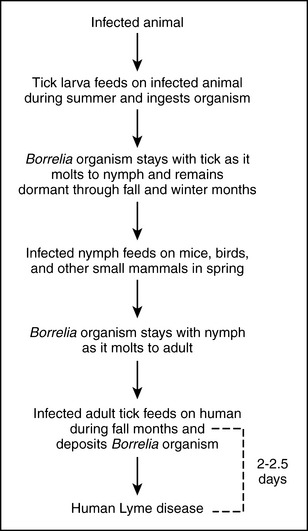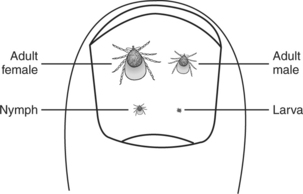LYME DISEASE
Lyme disease is a bacterial infection that affects many systems in the body. It is transmitted by tick bites and has become the most common arthropod-borne, human disease in the United States.
TRANSMISSION
The tick life cycle has three active stages after the egg hatches: larva, nymph, and adult (see Appendix 1). The larva must have a blood meal before it can molt to the nymph stage, and the nymph must have a blood meal before it can molt to the adult stage. A tick at each active stage can become infected when it takes a blood meal. The bacteria stay with the tick when it molts to the next stage. As it feeds before molting, a tick at each stage can infect another animal by depositing B. burgdorferi at the site of its bite. Typically the larva will feed on small rodents, like the white-footed mouse. If the mouse was infected, the larva becomes infected. Nymphs prefer feeding on many animals, such as small rodents, dogs, cats, horses, cattle, and humans. Similarly, if any of these animals were infected, the nymph would become infected. Adult ticks prefer to feed on whitetail deer. The life cycle takes 2 years to complete. Ticks can feed on people at any of the three stages (Figure 26).
Two ticks that can transmit Lyme disease to humans have been identified: the black-legged deer tick, Ixodes scapularis, in the northeastern and north central United States, and the western black-legged tick, Ixodes pacificus, on the Pacific coast of the United States. The larvae of both black-legged ticks are the size of a pin head and are tan colored. The nymphs are the size of a poppy seed and are beige or semitransparent. The adults are about the size of an apple seed and are black or reddish (Figure 27). For Lyme disease to occur, there must be B. burgdorferi, white-footed mice, and whitetail deer in an area.





